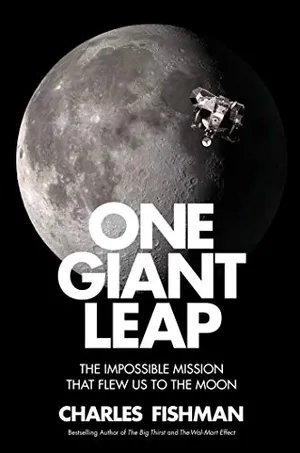The Moon has a smell. It has no air, but it has a smell. Each pair of Apollo astronauts to land on the Moon tramped lots of Moon dust back into the lunar module—it was deep gray, fine-grained and extremely clingy—and when they unsnapped their helmets, Neil Armstrong said, “We were aware of a new scent in the air of the cabin that clearly came from all the lunar material that had accumulated on and in our clothes.” To him, it was “the scent of wet ashes.” To his Apollo 11 crewmate Buzz Aldrin, it was “the smell in the air after a firecracker has gone off.”
All the astronauts who walked on the Moon noticed it, and many commented on it to Mission Control. Harrison Schmitt, the geologist who flew on Apollo 17, the last lunar landing, said after his second Moonwalk, “Smells like someone’s been firing a carbine in here.” Almost unaccountably, no one had warned lunar module pilot Jim Irwin about the dust. When he took off his helmet inside the cramped lunar module cabin, he said, “There’s a funny smell in here.” His Apollo 15 crewmate Dave Scott said: “Yeah, I think that’s the lunar dirt smell. Never smelled lunar dirt before, but we got most of it right here with us.”
Moon dust was a mystery that the National Aeronautics and Space Administration had, in fact, thought about. Cornell University astrophysicist Thomas Gold warned NASA that the dust had been isolated from oxygen for so long that it might well be highly chemically reactive. If too much dust was carried inside the lunar module’s cabin, the moment the astronauts repressurized it with air and the dust came into contact with oxygen, it might start burning, or even cause an explosion. (Gold, who correctly predicted early on that the Moon’s surface would be covered with powdery dust, also had warned NASA that the dust might be so deep that the lunar module and the astronauts themselves could sink irretrievably into it.)
Among the thousands of things they were keeping in mind while flying to the Moon, Armstrong and Aldrin had been briefed about the very small possibility that the lunar dust could ignite. “A late-July fireworks display on the Moon was not something advisable,” said Aldrin.
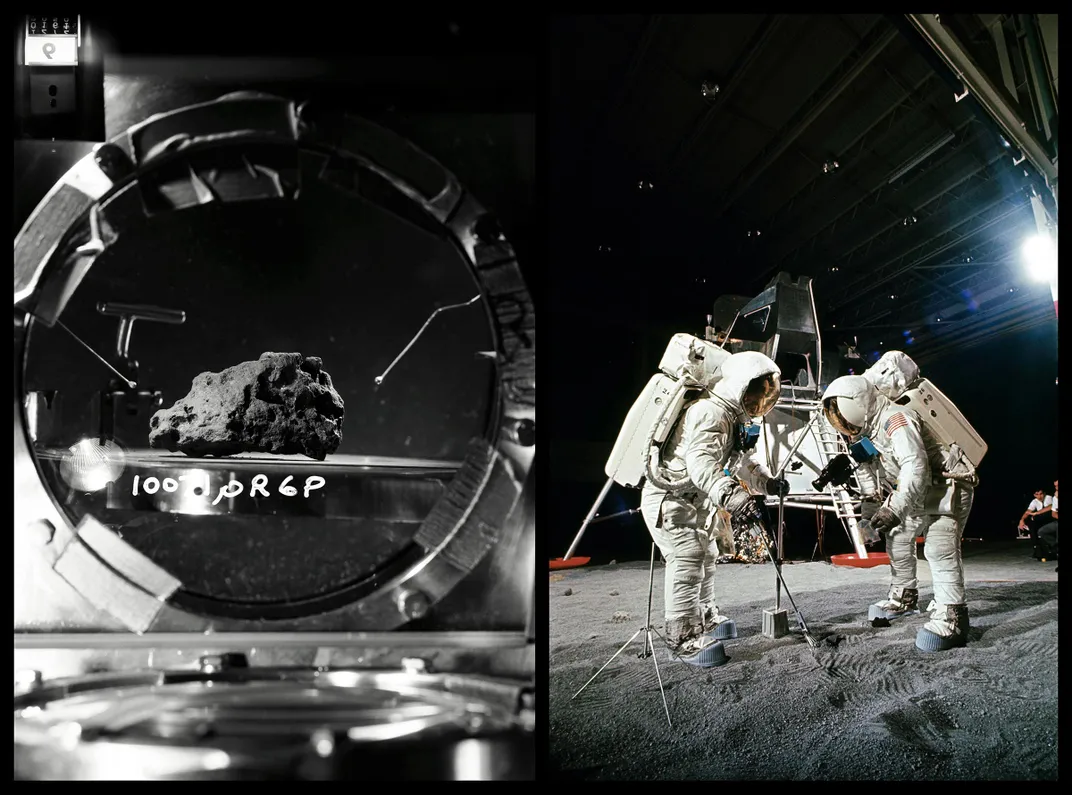
Armstrong and Aldrin did their own test. Just a moment after he became the first human being to step onto the Moon, Armstrong had scooped a bit of lunar dirt into a sample bag and put it in a pocket of his spacesuit—a contingency sample, in the event the astronauts had to leave suddenly without collecting rocks. Back inside the lunar module the duo opened the bag and spread the lunar soil on top of the ascent engine. As they repressurized the cabin, they watched to see if the dirt started to smolder. “If it did, we’d stop pressurization, open the hatch and toss it out,” Aldrin explained. “But nothing happened.”
The Moon dust turned out to be so clingy and so irritating that on the one night that Armstrong and Aldrin spent in the lunar module on the surface of the Moon, they slept in their helmets and gloves, in part to avoid breathing the dust floating around inside the cabin.
By the time the Moon rocks and dust got back to Earth—a total of 842 pounds from six lunar landings—the odor was gone from the samples, exposed to air and moisture in their storage boxes. No one has quite figured out what caused the odor to begin with, or why it was so like spent gunpowder, which is chemically nothing like Moon rock. “Very distinctive smell,” Apollo 12 commander Pete Conrad said. “I’ll never forget. And I’ve never smelled it again since then.”
* * *
In 1999, as the century was ending, the historian Arthur Schlesinger Jr. was among a group of people who was asked to name the most significant human achievement of the 20th century. In ranking the events, Schlesinger said, “I put DNA and penicillin and the computer and the microchip in the first ten because they’ve transformed civilization.” But in 500 years, if the United States of America still exists, most of its history will have faded to invisibility. “Pearl Harbor will be as remote as the War of the Roses,” said Schlesinger. “The one thing for which this century will be remembered 500 years from now was: This was the century when we began the exploration of space.” He picked the first Moon landing, Apollo 11, as the most significant event of the 20th century.
The trip from one small planet to its smaller nearby moon might someday seem as routine to us as a commercial flight today from Dallas to New York City. But it is hard to argue with Schlesinger’s larger observation: In the chronicle of humanity, the first missions by people from Earth through space to another planetary body are unlikely ever to be lost to history, to memory, or to storytelling.
The leap to the Moon in the 1960s was an astonishing accomplishment. But why? What made it astonishing? We’ve lost track not just of the details; we’ve lost track of the plot itself. What exactly was the hard part?
The answer is simple: When President John F. Kennedy declared in 1961 that the United States would go to the Moon, he was committing the nation to do something we simply couldn’t do. We didn’t have the tools or equipment—the rockets or the launchpads, the spacesuits or the computers or the micro-gravity food. And it isn’t just that we didn’t have what we would need; we didn’t even know what we would need. We didn’t have a list; no one in the world had a list. Indeed, our unpreparedness for the task goes a level deeper: We didn’t even know how to fly to the Moon. We didn’t know what course to fly to get there from here. And as the small example of lunar dirt shows, we didn’t know what we would find when we got there. Physicians worried that people wouldn’t be able to think in micro-gravity conditions. Mathematicians worried that we wouldn’t be able to calculate how to rendezvous two spacecraft in orbit—to bring them together in space and dock them in flight both perfectly and safely.
On May 25, 1961, when Kennedy asked Congress to send Americans to the Moon before the 1960s were over, NASA had no rockets to launch astronauts to the Moon, no computer portable enough to guide a spaceship to the Moon, no spacesuits to wear on the way, no spaceship to land astronauts on the surface (let alone a Moon car to let them drive around and explore), no network of tracking stations to talk to the astronauts en route.
“When [Kennedy] asked us to do that in 1961, it was impossible,” said Chris Kraft, the man who invented Mission Control. “We made it possible. We, the United States, made it possible.”
Ten thousand problems had to be solved to get us to the Moon. Every one of those challenges was tackled and mastered between May 1961 and July 1969. The astronauts, the nation, flew to the Moon because hundreds of thousands of scientists, engineers, managers and factory workers unraveled a series of puzzles, often without knowing whether the puzzle had a good solution.
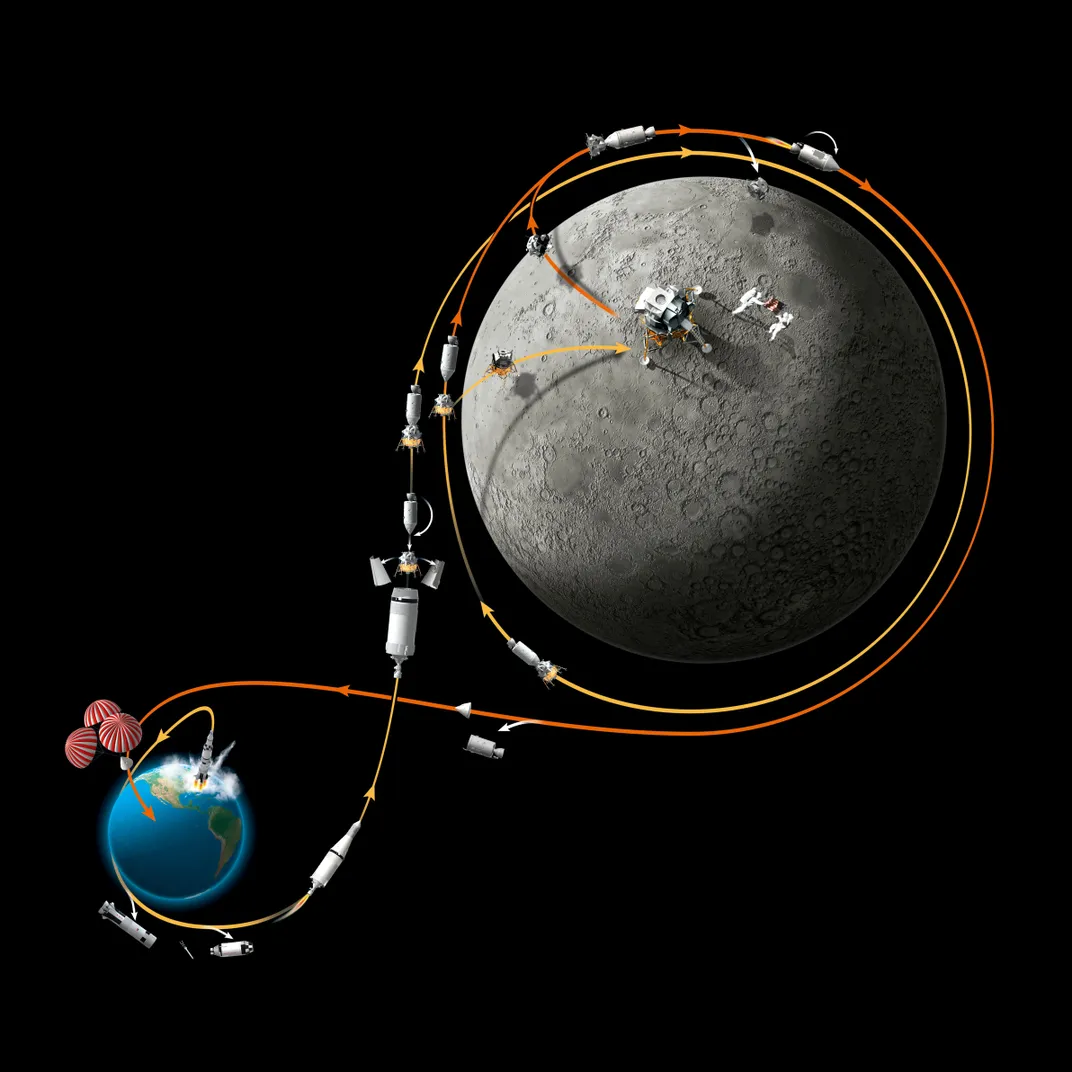
In retrospect, the results are both bold and bemusing. The Apollo spacecraft ended up with what was, for its time, the smallest, fastest and most nimble computer in a single package anywhere in the world. That computer navigated through space and helped the astronauts operate the ship. But the astronauts also traveled to the Moon with paper star charts so they could use a sextant to take star sightings—like 18th-century explorers on the deck of a ship—and cross-check their computer’s navigation. The software of the computer was stitched together by women sitting at specialized looms—using wire instead of thread. In fact, an arresting amount of work across Apollo was done by hand: The heat shield was applied to the spaceship by hand with a fancy caulking gun; the parachutes were sewn by hand, and then folded by hand. The only three staff members in the country who were trained and licensed to fold and pack the Apollo parachutes were considered so indispensable that NASA officials forbade them to ever ride in the same car, to avoid their all being injured in a single accident. Despite its high-tech aura, we have lost sight of the extent to which the lunar mission was handmade.
The race to the Moon in the 1960s was, in fact, a real race, motivated by the Cold War and sustained by politics. It has been only 50 years—not 500—and yet that part of the story too has faded.
One of the ribbons of magic running through the Apollo missions is that an all-out effort born from bitter rivalry ended up uniting the world in awe and joy and appreciation in a way it had never been united before and has never been united since.
The mission to land astronauts on the Moon is all the more compelling because it was part of a decade of transformation, tragedy and division in the United States. The nation’s lunar ambition, we tend to forget, was itself divisive. On the eve of the launch of Apollo 11, civil rights protesters, led by the Rev. Ralph Abernathy, marched on Cape Kennedy.
In that way, the story of Apollo holds echoes and lessons for our own era. A nation determined to accomplish something big and worthwhile can do it, even when the goal seems beyond reach, even when the nation is divided. Kennedy said of the Apollo mission that it was hard—we were going to the Moon precisely because doing so was hard—and that it would “serve to organize and measure the best of our energies and skills.” And measure the breadth of our spirit as well.
* * *
Today the Moon landing has ascended to the realm of American mythology. In our imaginations, it’s a snippet of crackly audio, a calm and slightly hesitant Neil Armstrong stepping from the ladder onto the surface of the Moon, saying, “That’s one small step for man, one giant leap for mankind.” It is such a landmark accomplishment that the decade-long journey has been concentrated into a single event, as if on a summer day in 1969, three men climbed into a rocket, flew to the Moon, pulled on their spacesuits, took a few steps, planted the American flag, and then came home.
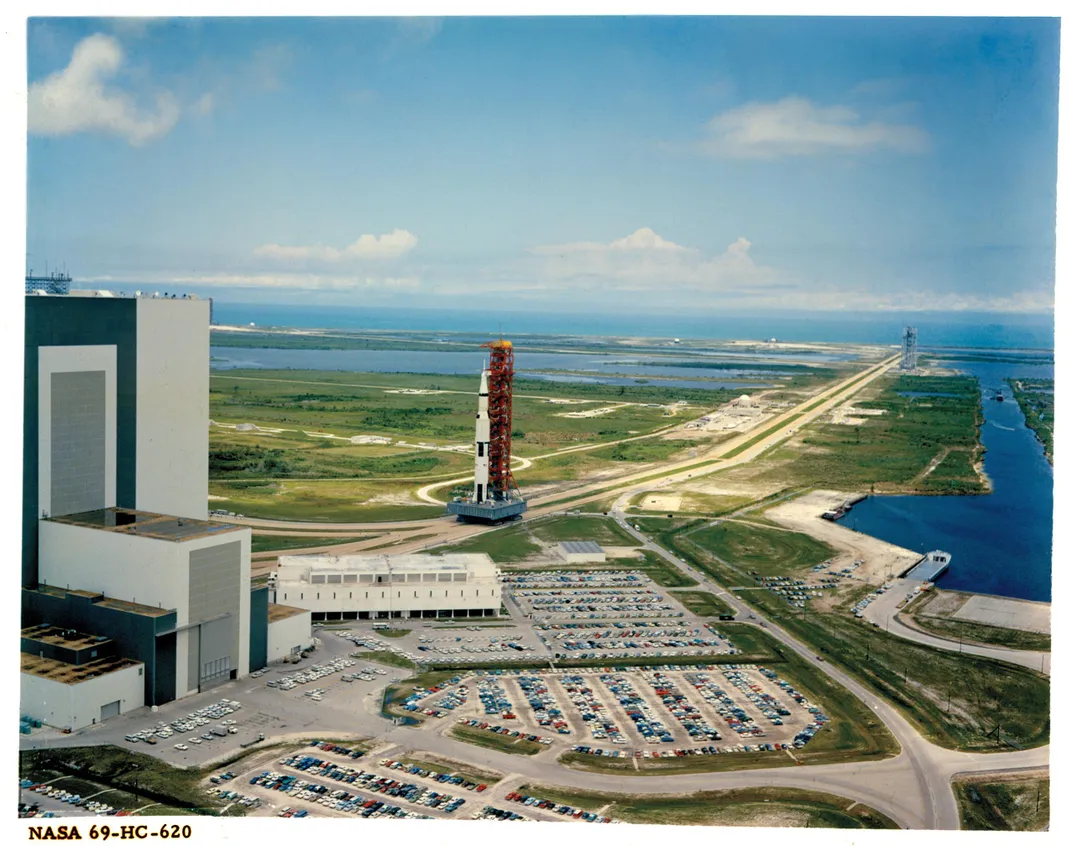
But the magic, of course, was the result of an incredible effort—an effort unlike any that had been seen before. Three times as many people worked on Apollo as on the Manhattan Project to create the atomic bomb. In 1961, the year Kennedy formally announced Apollo, NASA spent $1 million on the program for the year. Five years later NASA was spending about $1 million every three hours on Apollo, 24 hours a day.
One myth holds that Americans enthusiastically supported NASA and the space program, that Americans wanted to go to the Moon. In fact two American presidents in a row hauled the space program all the way to the Moon with not even half of Americans saying they thought it was worthwhile. The ’60s were tumultuous, riven by the Vietnam War, urban riots, the assassinations. Americans constantly questioned why we were going to the Moon when we couldn’t handle our problems on Earth.
As early as 1964, when asked if America should “go all out to beat the Russians in a manned flight to the Moon,” only 26 percent of Americans said yes. During Christmas 1968, NASA sent three astronauts in an Apollo capsule all the way to the Moon, where they orbited just 70 miles over the surface, and on Christmas Eve, in a live, prime-time TV broadcast, they shared pictures of the Moon’s surface, as seen out their windows. Then the three astronauts, Bill Anders, Jim Lovell and Frank Borman, read aloud the first ten verses of Genesis to what was then the largest TV audience in history. From orbit, Anders took one of the most famous pictures of all time, the photo of the Earth floating in space above the Moon, the first full-color photo of Earth from space, later titled Earthrise, a single image credited with helping inspire the modern environmental movement.
* * *
Anticipation for the actual Moon landing should have been extraordinary. In fact, as earlier in the decade, and despite years of saturation coverage of Apollo and the astronauts, it was anything but universal. Four weeks after Apollo 8’s telecast from lunar orbit, the Harris Poll conducted a survey and asked Americans if they favored landing a man on the Moon. Only 39 percent said yes. Asked if they thought the space program was worth the $4 billion a year it was costing, 55 percent of Americans said no. That year, 1968, the war in Vietnam had cost $19.3 billion, more than the total cost of Apollo to that point, and had taken the lives of 16,899 U.S. troops—almost 50 dead every single day—by far the worst single year of the war for the U.S. military. Americans would prove to be delighted to have flown to the Moon, but they were not preoccupied by it.
The big myth of Apollo is that it was somehow a failure, or at least a disappointment. That’s certainly the conventional wisdom—that while the landings were a triumph, the aimless U.S. space program since then means Apollo itself was also pointless. Where is the Mars landing? Where are the Moon bases, the network of orbital outposts? We haven’t done any of that, and we’re decades from doing it now. That misunderstands Apollo, though. The success is the very age we live in now. The race to the Moon didn’t usher in the space age; it ushered in the digital age.
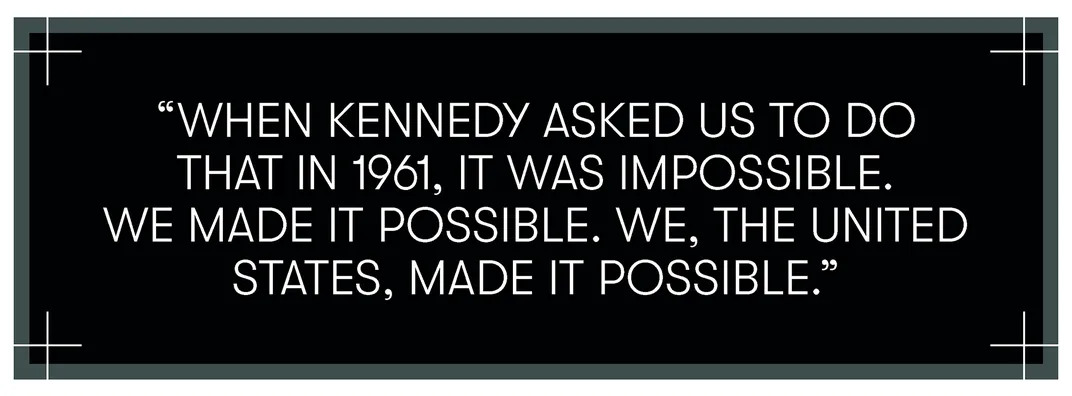
Historians of Silicon Valley and its origins may skip briskly past Apollo and NASA, which seem to have operated in a parallel world without much connection to or impact on the wizards of Intel and Microsoft. But the space program in the 1960s did two things to lay the foundation of the digital revolution. First, NASA used integrated circuits—the first computer chips—in the computers that flew the Apollo command module and the Apollo lunar module. Except for the U.S. Air Force, NASA was the first significant customer for integrated circuits. Microchips power the world now, of course, but in 1962 they were little more than three years old, and for Apollo they were a brilliant if controversial bet. Even IBM decided against using them in the company’s computers in the early 1960s. NASA’s demand for integrated circuits, and its insistence on their near-flawless manufacture, helped create the world market for the chips and helped cut the price by 90 percent in five years.
NASA was the first organization of any kind—company or government agency—anywhere in the world to give computer chips responsibility for human life. If the chips could be depended on to fly astronauts safely to the Moon, they were probably good enough for computers that would run chemical plants or analyze advertising data.
NASA also introduced Americans, and the world, to the culture and power of technology—we watched on TV for a decade as staff members at Mission Control used computers to fly spaceships to the Moon. Part of that was NASA introducing the rest of the world to “real-time computing,” a phrase that seems redundant to anyone who’s been using a computer since the late 1970s. But in 1961, there was almost no computing in which an ordinary person—an engineer, a scientist, a mathematician—sat at a machine, asked it to do calculations and got the answers while sitting there. Instead you submitted your programs on stacks of punch cards, and you got back piles of printouts based on the computer’s run of your cards—and you got those printouts hours or days later.
But the Apollo spacecraft—command module and lunar module—were flying to the Moon at almost 24,000 miles per hour. That’s six miles every second. The astronauts couldn’t wait a minute for their calculations; in fact, if they wanted to arrive at the right spot on the Moon, they couldn’t wait a second. In an era when even the batch-processing machines took up vast rooms of floor space, the Apollo spacecraft had real-time computers that fit into a single cubic foot, a stunning feat of both engineering and programming.
Kennedy’s call to leap to the Moon ahead of the Russians was greeted with wild enthusiasm in the spring and summer of 1961. But when it came to public events, Americans’ attention spans were no longer in the 1960s than they are today. We were no more inclined toward the virtues of slow-and-steady progress, no more capable of delayed gratification. Even before 1961 was over, there were prominent public voices stoking skepticism and dissent about the value of the Moon race.
In 1961, Senator Paul H. Douglas released his own poll, not of the American people but of U.S. space scientists. The question: Was sending astronauts to the Moon, “at the earliest feasible moment,” of great scientific value? Douglas had arranged to poll the membership of the American Astronomical Society, and received 381 written replies from astronomers and space scientists. Of those, 36 percent said a manned Moon mission had “great scientific value,” and 35 percent said it had “little scientific value.” And unmanned, robotic missions to the Moon? Sixty-six percent of space scientists said they would have “great scientific value.” Douglas, a liberal Democrat, was a member of Kennedy’s own party, and he had gone to some trouble to establish that America’s actual space scientists judged that the race to the Moon wasn’t worth it. “If the astronomers are not competent [to decide],” asked Douglas, “who is?”
Norbert Wiener, a professor and legendary mathematician at MIT, dismissed Apollo in a late 1961 interview as a “moondoggle,” a word the press and NASA critics loved; through the end of 1961 and into 1962, “moondoggle” started to pop up regularly in coverage of the space program, particularly in stories about spending and in editorials.
In January 1962 the New York Times published an editorial pointing out that “the grand total for the Moon excursion would reproduce from 75 to 120 universities about the size of Harvard, with some [money] left over”—a Moon landing, or a Harvard University for every state?
In August 1962 the Russians launched two cosmonauts, in separate spaceships, within 24 hours of each other, the double mission totaling seven days in space at a moment when the total for all four American spaceflights was 11 hours. Kennedy was asked at a press conference why Americans shouldn’t be pessimistic since they were not just second to the Soviets but “now a poor second.” “We are behind and we are going to be behind for a while,” he replied. “But I believe that before the end of this decade is out, the United States will be ahead....This year we submitted a space budget which was greater than the combined eight space budgets of the previous eight years.” The press conference comments were defensive and reflexive. There was no eloquence about space in them, the responses more dutiful than enthusiastic.
* * *
In the fall of 1962, Kennedy did a two-day tour of space facilities to see for himself how the Moon program was taking shape. Huntsville, Alabama, home to Wernher von Braun’s rocket team, was the first stop. Von Braun showed the president a model of the Saturn rocket that would eventually launch astronauts to the Moon. “This is the vehicle which is designed to fulfill your promise to put a man on the Moon by the end of the decade,” von Braun told Kennedy. He paused, then added, “By God, we’ll do it!”
Von Braun took Kennedy to the firing of a Saturn C-1 rocket as a demonstration of the coming power of American rocketry. The test—eight engines firing simultaneously, roaring red-orange rocket thrust out of a test stand, with Kennedy, von Braun and the visiting party in a viewing bunker less than a half-mile away—shook the ground and sent shock waves across the Alabama test facility. When the engines stilled, Kennedy turned with a wide grin to von Braun and grabbed his hand in congratulations. The president was apparently so captivated by von Braun’s running commentary that he took the rocket scientist—the biggest U.S. space personality outside the astronauts themselves—on the plane with him to Cape Canaveral.
At the cape, JFK visited four launchpads, including one where he got a guided tour from astronaut Wally Schirra of the Atlas rocket and Mercury capsule Schirra was set to ride into orbit in about two weeks.
Kennedy ended the day in Houston, where his popularity was on vivid display. The city’s police chief said 200,000 people—more than one in every five residents of Houston at the time—had come out to see the president, who rode in an open car from the airport to his hotel. Kennedy spent part of the next day at NASA’s temporary Houston facilities—the space center itself was under construction—including seeing a very early mock-up of the lunar module, then called “the bug.” But the emotional and political climax of Kennedy’s tour came Wednesday morning at the Rice University football stadium. In the blazing early-morning Texas heat—already 89 degree at 10 a.m., with Kennedy and his party wearing dress shirts, coats and ties—the president gave a speech designed to lift the space program up out of the political squabbles and budget bickering that was starting to beset it. “The United States was not built by those who waited and rested,” he said. “This country was conquered by those who moved forward—and so will space.”
* * *
Space didn’t just create the opportunity for knowledge and adventure, for American destiny and American values. It created an obligation to reach for the Moon, and to reach beyond.
That is the point of the most famous passage of the Rice University speech: “We choose to go to the Moon. We choose to go to the Moon....We choose to go to the Moon, in this decade, and do the other things, not because they are easy, but because they are hard, because that goal will serve to organize and measure the best of our energies and skills, because that challenge is one that we are willing to accept, one we are unwilling to postpone, and one which we intend to win, and the others, too.”
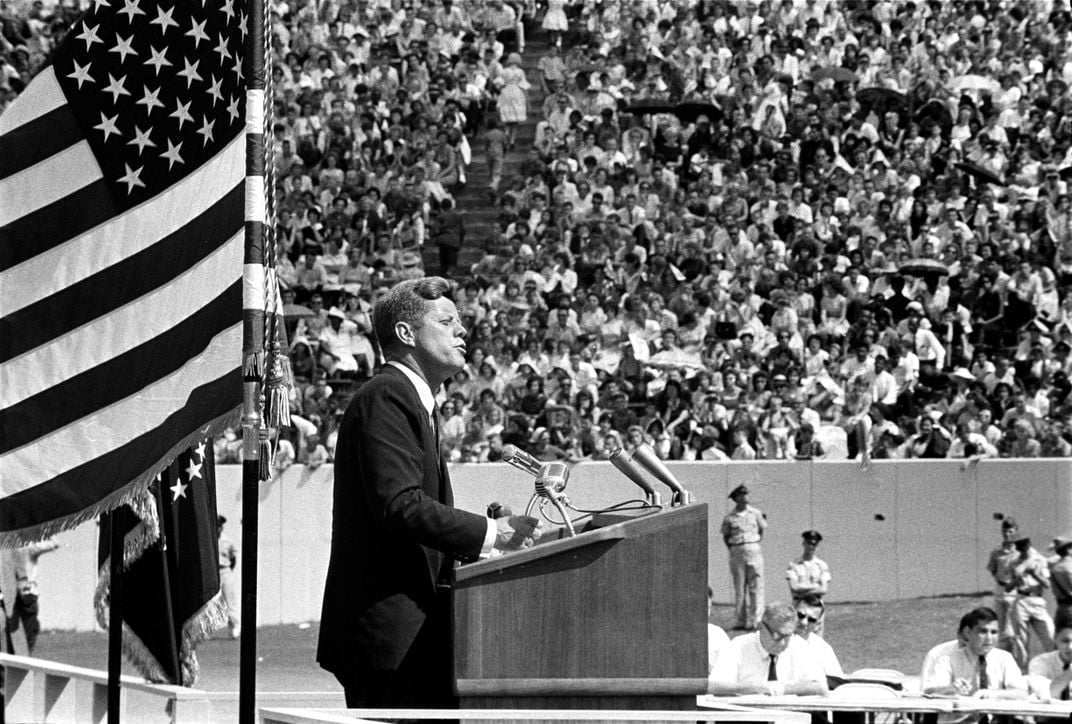
The Rice speech took place on September 12, 1962. Ten weeks later, on November 21, in the cabinet room, Kennedy presided over a meeting about America’s space program with a very different tone. It was fractious and frustrating, driven by the president’s own impatience. He didn’t like the slow pace of the program; he didn’t like what it was costing; and he didn’t like the answers he was getting from the people gathered around the table with him, including James Webb, the NASA administrator, and his most senior lieutenants.
Ostensibly the occasion for the meeting was to hash out whether NASA and Kennedy were going to push Congress for an extra $400 million for Apollo before the next budget cycle. Not even the NASA people agreed about the wisdom of that.
The poetry of the Rice speech, the vision of the future it expressed, is nowhere to be found in the cabinet room that Wednesday. We know this because, although the meeting was private, Kennedy had a secret taping system installed in the White House, as FDR had, as LBJ would, as Nixon, most famously, would.
The recordings preserve two high-level conversations about space that reveal a very different Kennedy attitude about the race to the Moon. At the first, just ten weeks after his Rice University speech, Kennedy spent 30 minutes asking questions about NASA’s budget and spending, trying to get to the bottom of the schedule. “Gemini has slipped how much?” he asked.
To much laughter—there were nine people in the meeting besides the president, four of them space agency people all too familiar with countdowns and launches that frequently slipped—Webb responded, “This word ‘slip’ is the wrong word.” To which Kennedy says, “I’m sorry, I’ll pick another word.”
Webb had been telling Kennedy that a Moon landing was possible in late 1967, but was more likely in 1968. Kennedy wanted it sooner. How do you move it back into 1967? Would the $400 million they were there to discuss do that? How about early 1967? What would that take? Kennedy seemed puzzled that more money wouldn’t necessarily make it happen sooner.
There is a long exchange in which Kennedy tries to understand why getting $400 million extra right now would help Gemini but wasn’t likely to move Apollo any sooner. He didn’t understand the details of staged technology development, that you have to build and fly Gemini in part to help you make the right decisions about Apollo. Four months here or there over four years is hard to nail down.
Thirty minutes into the conversation, the president takes a step back. “Do you think this program is the top-priority program of the agency?” Kennedy asked Webb.
“No sir, I do not,” Webb answered without hesitation.“I think it is one of the top priority programs, but I think it’s very important to recognize here—” Webb started to explain the importance of some of NASA’s non-Moon programs. Kennedy lowered his voice and simply stepped into Webb’s conversational stream.
“Jim, I think it is the top priority. I think we ought to have that very clear. This is, whether we like it or not, in a sense a race. If we get second to the Moon, it’s nice, but it’s like being second any time. So that if we’re second by six months, because we didn’t give it the kind of priority—then of course that would be very serious.”
The president was being as clear as he possibly could. It was fine to fly to the Moon, but the point of such urgency—the tripling of NASA’s budget in just two years—was to reach the Moon before the Russians. It didn’t seem clear to the people in the White House cabinet room that day, but the only reason they were there at all was that Kennedy needed to beat the Russians. Not because he needed to fly to the Moon.
“Otherwise, we shouldn’t be spending this kind of money, because I’m not that interested in space.”
* * *
The conversation continued well after Kennedy lost patience, and left. But no one took up, or even commented on, those arresting words, which must have been quite stunning to the space people in the room: I’m not that interested in space. The man who launched the United States to the Moon, “the greatest adventure on which man has ever embarked,” as he called it at Rice, just wanted to get there before the Russians.
In 1963 the politics of going to the Moon got even more challenging than they were in 1962. Webb was worried about the scientific community, many of whom felt that a space program that sent humans into space would consume huge amounts of federal money that could be used for scientific research with more immediate value on Earth.
In April, in an editorial in the prestigious journal Science, the editor, Philip Abelson, provided precisely the cerebral, almost disdainful critique Webb had been hearing in his conversations with scientists. Abelson walked through the justifications—military value, technological innovation, scientific discovery and the propaganda value of beating the Russians—and dismissed each in turn. “Military applications seem remote,” he wrote. The technological innovations “have not been impressive.” If actual science was a goal—and no scientist was on any imagined Moon landing crew yet—“most of the interesting questions about the Moon can be studied by electronic devices,” at about 1 percent of the cost of using astronauts.
As for the worldwide prestige, “the lasting propaganda value of placing a man on the Moon has been vastly overestimated. The first lunar landing will be a great occasion; subsequent boredom is inevitable.”
On June 10, Abelson was among a group of ten scientists called to testify, over two days, before the Senate Committee on Aeronautical and Space Sciences about the future of Apollo. Abelson, a physicist and a key contributor to the creation of the atomic bomb, told the senators, “[The] diversion of talent to the space program is having and will have direct and indirect damaging effects on almost every area of science, technology and medicine. I believe that [Apollo] may delay the conquest of cancer and mental illness. I don’t see anything magical about this decade. The Moon has been there a long time, and will continue to be there a long time.”
Two days later, former president Dwight Eisenhower spoke to a breakfast gathering of Republican members of Congress in Washington, where he was sharply critical of Kennedy’s spending plans overall. Asked about the space budget, Eisenhower replied, “Anybody who would spend $40 billion in a race to the Moon for national prestige is nuts.” The line drew sustained applause from the 160 Republican congressmen at the event. Leave aside that Eisenhower was going with the most extreme estimate of the Moon cost (one that didn’t come close to true in reality, even nine years later), that was the immediate past president of the United States calling the current president of the United States crazy. Headline writers from one side of America to the other loved the story, which made the front pages of dozens of newspapers with some variation of the headline “Ike Calls Moon Race ‘Nuts.’”
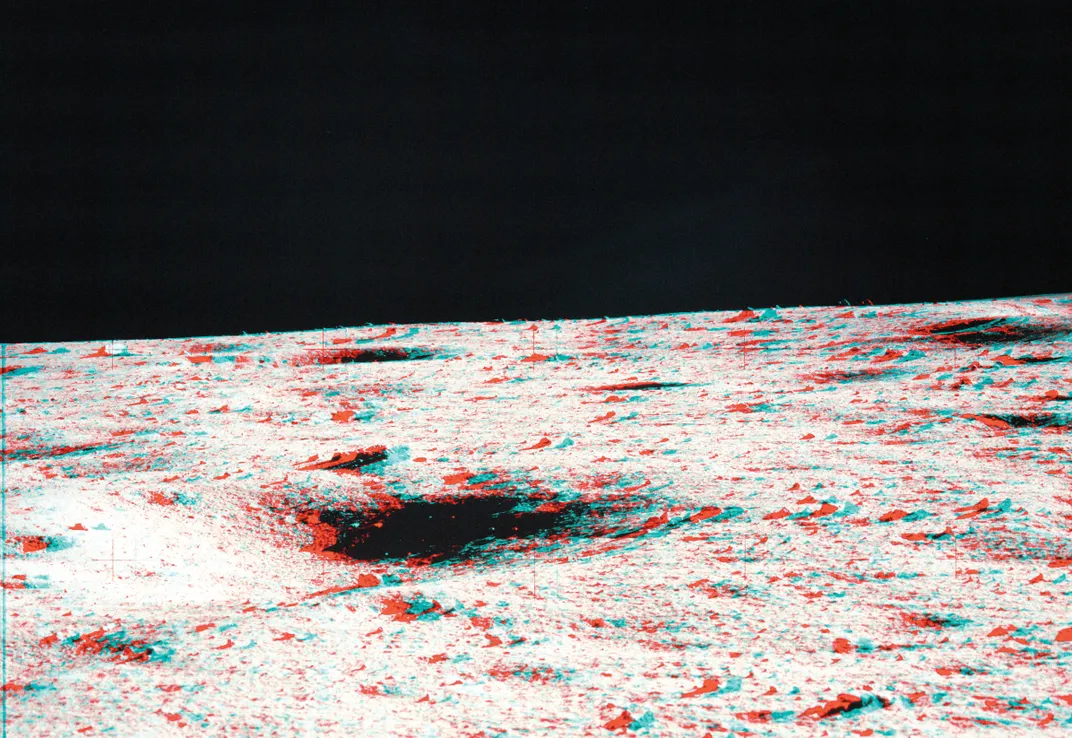
As it happens, on that day NASA announced the end of the Mercury program, the small capsules with just a single astronaut. Next up, the much more sophisticated, and much more ambitious, missions of Gemini. But the last Mercury flight was May 1963, and the first manned Gemini flight wouldn’t come until March 1965—a long time between “space spectaculars,” as Kennedy called them, to fire the public imagination, and enough time for an entire presidential and congressional election to play out without a single spaceflight.
In Congress, which was also thinking about elections coming the following year, NASA had gone from receiving near-unanimous support after Kennedy’s initial “go to the Moon” speech to being viewed as an agency where money might be harvested for other purposes.
* * *
As if to underscore the shift in public attitude, on September 13, 1963, the Saturday Evening Post, one of the widest circulation weekly magazines in the country, published a story titled “Are We Wasting Billions in Space?” On the cover the headline was just “Billions Wasted in Space,” without the question mark, a crisper summary of the story’s point. The Moon race, the story argued, had become a “boondoggle” and “a circus.”
The second recorded meeting that reveals Kennedy’s private thinking about space took place on September 18, 1963, in the Oval Office. Only President Kennedy and Jim Webb were present. On August 5, the United States, the USSR and Great Britain had signed a partial nuclear test-ban treaty, the first limits on nuclear weapons, and a major thaw in the Cold War. This meeting with Webb was long—46 minutes. The question was how to sustain Apollo during what were clearly going to be years of spending without years of excitement.
Right at the start, Kennedy said, “It’s been a couple years, and...right now, I don’t think the space program has much political excitement.”
“I agree,” said Webb. “I think this is a real problem.”
“I mean, if the Russians do some tremendous feat, then it would stimulate interest again,” continued Kennedy. “But right now, space has lost a lot of its glamour.”
The immediate cuts that congressional committees had proposed to the NASA budget would slow America’s leap to the Moon. Kennedy asked, “If we’re cut that amount...we slip a year?”
“We’ll slip at least a year,” replied Webb.
Kennedy: “If I get re-elected, we’re not going to the Moon in our period, are we?”
Webb: “No. No. You’re not going.”
Kennedy: “We’re not going...”
Webb: “You’ll fly by it.”
Webb was saying that, during Kennedy’s term, astronauts would fly around the Moon without landing, as Apollo 8 did, in fact, in December 1968, which would have been the end of the last year of Kennedy’s second term.
“It’s just going to take longer than that,” Webb said. “This is a tough job. A real tough job.”
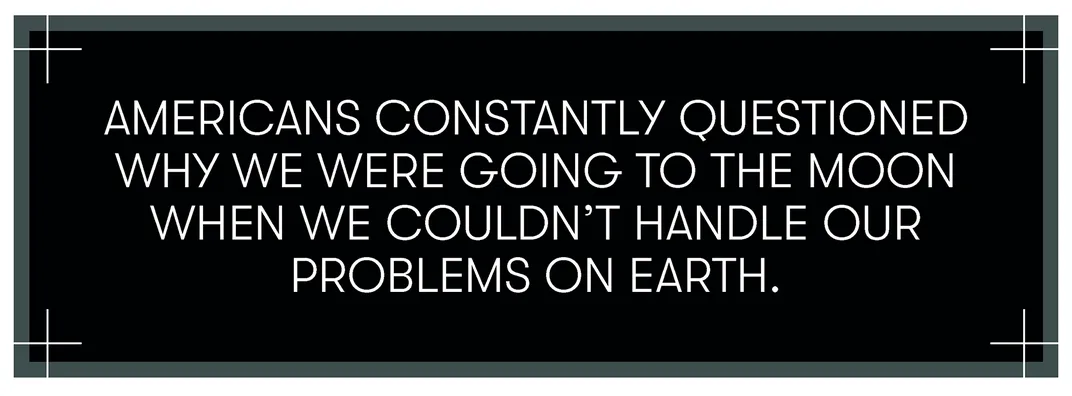
It’s hard to listen to the conversation while setting aside everything we know that would come in the next ten weeks, and the next six years, and just imagine it from Kennedy’s point of view. This huge project he had set in motion. He wasn’t even done with his first term. Congressional critics weren’t just talking down the Moon landing; they were cutting the budget for the Moon landing. And Kennedy wouldn’t just have to muster the political support for Apollo through the election in a year; he was imagining having to sustain support for it through his entire next term, to which he hadn’t been re-elected yet. And even if he could do it, he wouldn’t enjoy the accomplishment during his own presidency.
It would have been a keen moment of disappointment, and you can hear it in Kennedy’s voice. It would also have been a moment of political calculation. How do you possibly hang on to a discretionary program of such enormous scale, already under fire, through four more budget cycles?
Just after that, Kennedy asked a version of the same question he had asked a year earlier: “Do you think the manned landing on the Moon’s a good idea?”
“Yes sir,” replied Webb. “I think it is.”
To Kennedy, the broader politics were simple and discouraging: “We don’t have anything coming up for the next 14 months. So I’m going into the campaign to defend this program, and we won’t have had anything for a year and a half.” He actually sounded disappointed, almost irritated by the timing of this flight gap. How could he talk with enthusiasm about space, when there were no spaceflights for anyone to be enthusiastic about?
In fact Kennedy saw only one strategy for protecting Apollo, an extension of the very first reasoning behind the Moon race. “I want to get the military shield over this thing,” he said, meaning, he wanted to be able to argue that manned spaceflight had explicit national security and defense value.
Webb went deep into the budget negotiations with Kennedy, talking about congressmen by name, but he also pulled back to remind the president of the incredible power of this kind of exploration and science for the life of Americans, for understanding how the world works, and also for the practical value of technology development, and for inspiring American students to pursue science and engineering. “The younger folks see this much better than my generation,” Webb said, having visited high schools and colleges around the country. He was talking about all the things that made Americans nervous after Sputnik, all the things Kennedy himself so forcefully argued in his Rice University speech. The lunar landing, said Webb, is “one of the most important things that’s been done in this nation.” What will come from going to the Moon will be “staggering things in terms of the development of the human intellect.”
The NASA chief concluded, “I predict you are not going to be sorry—ever—that you did this.”
* * *
On Thursday, October 10, 1963, the House passed the slimmed down $5.1 billion NASA budget—$600 million less than Kennedy requested, at least $200 million less than Webb had said was necessary to stay on track for a Moon landing within the decade. That seemed to be sending an ominous signal about the fading sense of congressional urgency and enthusiasm for reaching the Moon by the end of the decade.
So if John Kennedy had not been assassinated, would Neil Armstrong and Buzz Aldrin have stepped off the ladder of the lunar module Eagle onto the Moon on July 20, 1969?
It seems unlikely.
President Kennedy visited Cape Canaveral for the third time, on November 16, flying up from where he was spending the weekend in Palm Beach, for two hours of briefings and touring. He got to see the Saturn I rocket on its launchpad, the rocket that would, a month later, finally put into orbit a payload larger than anything the Russians could launch. “It will give the United States the largest booster in the world and show significant progress in space,” the president said. The Saturn I was scheduled to launch in December; it ended up being launched successfully on January 29, 1964, sending ten tons into Earth orbit in a milestone considered so significant that the midday event was carried live by the TV networks.
After a brief return to Washington, Kennedy headed to Texas the following Thursday, November 21, to make appearances in San Antonio, then Houston, followed by Fort Worth and Dallas. In San Antonio he dedicated a new Air Force research center devoted to aerospace medicine. He commented on how valuable space medical research would prove: “Medicine in space is going to make our lives healthier and happier here on Earth.” He told the audience how impressed he was with the Saturn rocket he had seen the previous Saturday. There will be “pressures in this country to do less in this area as in so many others, and temptations to do something else that is perhaps easier. But...the conquest of space must and will go ahead.” He didn’t mention landing on the Moon.
In the speech that had been written for him to give in Dallas at the Dallas Trade Mart—the speech he was on the way to deliver when he was shot—Kennedy would have talked with pride about reinvigorating the U.S. space program. Under his administration, the nation was spending more money on space each year than the entire space budget for the decade of the Fifties; 130 U.S. spacecraft had been put in orbit, including invaluable and innovative weather and communications satellites, “making it clear to all that the United States of America has no intention of finishing second in space.” Space was a source of “national strength.”
Kennedy hadn’t planned to say a word that afternoon about going to the Moon.
From the evidence at hand, it’s actually hard to imagine Kennedy making the Moon landing itself a cornerstone of his second term. He had lots of other things he wanted to do.
But none of that happened, because Kennedy was killed on Friday, November 22, 1963.
Six days later President Lyndon B. Johnson announced, in his somber Thanksgiving Day address to the nation, that he was renaming the space center in Florida the John F. Kennedy Space Center and renaming the piece of land it sat on Cape Kennedy. In a brief meeting the day before, Jacqueline Kennedy had asked Johnson to do that, and he had agreed.
Before noon on the Friday after Thanksgiving, not even 18 hours after Johnson’s announcement, painters hung a sign with the new name on it over the southern security gate for Kennedy Space Center.

On January 21, 1964, President Johnson submitted to Congress his budget for the next year, proposing to cut overall federal spending from Kennedy’s previous budget by $500 million, including cuts to defense, agriculture, veterans affairs and the post office. But Johnson raised spending for NASA to $5.3 billion, along with a request to immediately add back $141 million for the year already under way. Whatever Kennedy’s long-term space strategy had been, his death changed the political calculation, in space as in so many other arenas. Johnson, unlike Kennedy, was an authentic believer in the space program. In announcing the NASA budget, he reaffirmed his determination to get the nation to the Moon by 1970. “No matter how brilliant our scientists and engineers, how farsighted our planners and managers, or how frugal our administrators and contracting personnel, we cannot reach this goal without adequate funds,” Johnson said. “There is no second-class ticket to space.”
* * *
By March 1964 the most sophisticated spaceship ever conceived was well along in its design. The Apollo lunar module would carry two astronauts from lunar orbit to the Moon’s surface, be their base of operations on the Moon, then rocket them back to orbit and rendezvous with the command module. The lunar module—known as the “lem,” abbreviated LM—was being designed and built on Long Island, at the same factory where, 20 years earlier, Grumman Corporation had produced 12,275 Hellcat fighters for World War II.
As Grumman conceived the lunar module, it was a two-stage spacecraft; the full ship would land on the Moon, but only the small upper stage and crew compartment would blast off from the Moon and return the astronauts to the command module, in orbit. So the lunar module had two rocket engines, a big one to land the ship, and a smaller one to blast the crew compartment back into orbit. Each of those rocket engines weighed less than the engine in a typical midsize car—and each was a marvel. The descent engine could be throttled: powerful thrust to bring the lunar module down to the Moon from orbit, and lower thrust to allow the LM to hover near the surface of the Moon while the astronauts picked a final landing spot. No rocket engine before had ever had variable power. The smaller engine, which would return the astronauts to the command module, absolutely had to work when the launch command was given. If it didn’t ignite, the astronauts were trapped on the Moon. So the ascent engine was a study in simplicity to reduce the number of ways it could fail.
The lunar module would have sophisticated navigation, electronics and life-support systems, and it would also have storage lockers for bringing home Moon rocks. By 1964, the design was already evolving. The cabin had already been refined to accommodate bulky spacesuits; the seats had been eliminated, and the windows made smaller, to reduce weight; the LM had gone from having five legs, which would have provided maximum stability, to having four legs, which allowed room for bigger fuel tanks.
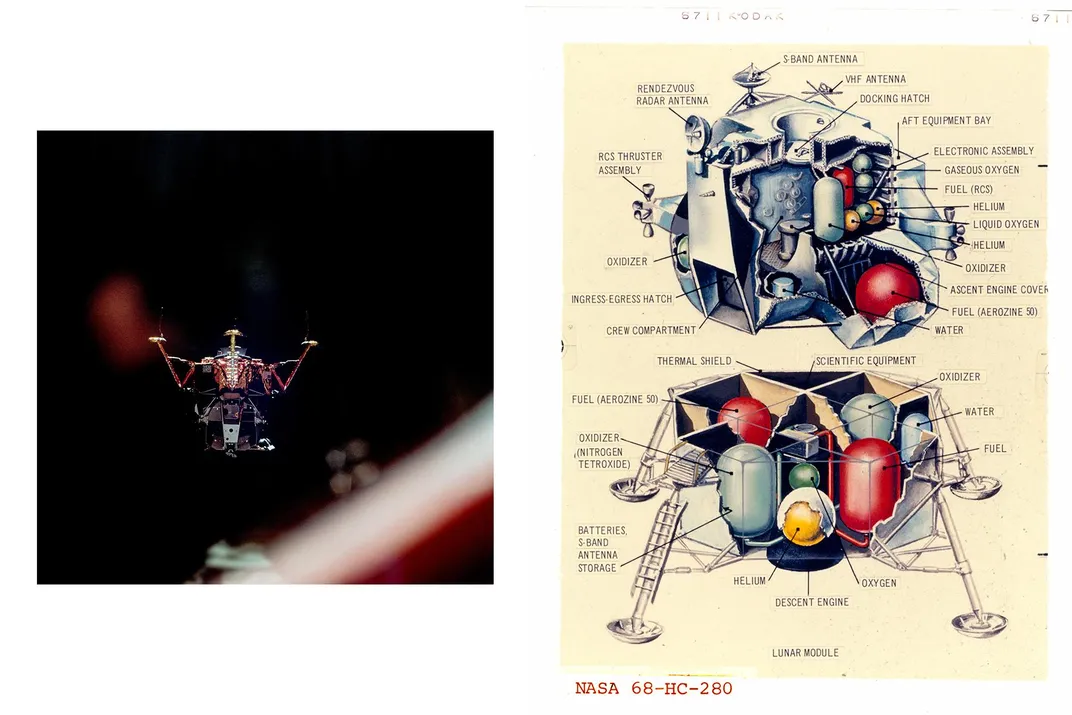
The LM was, in fact, perhaps the strangest flying craft ever created. It was the first, and remains the only, manned spacecraft designed solely for use off Earth. It would never have to fly through an atmosphere, so it didn’t need the structural robustness that would require. It also didn’t need to be aerodynamic. It would only fly in space, and then it would be left in space or on the Moon’s surface.
The lunar module’s other significant challenge was that it could never be test-flown before being used for its critical role. There’s no place on Earth to take a spaceship designed for flight in a zero-gravity vacuum and fly it around. So the people who would pilot the lunar modules to the Moon never practiced flying them, except in simulators, which were designed and built by people who had never flown a lunar module.
In the end, Grumman manufactured 14 flight-ready lunar modules. The company that during World War II had been able to produce 14 Hellcat fighter planes a day needed a decade to produce 14 spaceships. That’s a measure of the learning curve, to be sure, but also a measure of the difference in complexity between a high-performance warplane and a high-performance spacecraft.
Ten of the flight-ready lunar modules Grumman built flew in space, and six of those landed on the Moon. The total cost of the lunar modules was $1.6 billion ($11 billion in 2019 dollars); each one cost $110 million, although by the time lunar modules were flying to the Moon, Grumman said it could produce a new one for just $40 million, if anyone wanted one.
Given how novel the machine was, and how novel its flight profile was, one thing that’s surprising is how little the astronauts talked about the experience of actually flying it. When you read the mission transcripts during the time astronauts were in the lunar module and flying it, the experience itself is so demanding and so absorbing that there’s almost no idle time and no idle exchanges with Mission Control.
Neil Armstrong, just after descending to the Moon in Apollo 11’s LM, said, “The Eagle has wings.”* And as Pete Conrad and Alan Bean rocketed back off the Moon in Apollo 12, in the lunar module they had given the call sign Intrepid, Conrad radioed perhaps the only line that the folks at Grumman, or the lunar modules themselves, needed: “I tell you, Houston, I sure do enjoy flying this thing.”
* * *
For the first Moonwalk ever, Sonny Reihm was inside NASA’s Mission Control building, watching every move on the big screen. Reihm was a supervisor for the most important Moon technology after the lunar module itself: the spacesuits, the helmets, the Moonwalk boots. And as Neil Armstrong and Buzz Aldrin got comfortable bouncing around on the Moon and got to work, Reihm got more and more uncomfortable.

The spacesuits themselves were fine. They were the work of Playtex, the folks who brought America the “Cross Your Heart Bra” in the mid-1950s. Playtex had sold the skill of its industrial division to NASA in part with the cheeky observation that the company had a lot of expertise developing clothing that had to be flexible as well as form-fitting.
It was when the cavorting started on the Moon that Reihm got butterflies in his stomach. Aldrin had spent half an hour bumping around in his spacesuit, with his big round helmet, when all of a sudden, here he came bounding from foot to foot like a kid at a playground, right at the video camera he and Armstrong had set up at the far side of their landing site.
Aldrin was romping straight at the world, growing larger and larger, and he was talking about how he’d discovered that you have to watch yourself when you start bouncing around, because you couldn’t quite trust your sense of balance in Moon gravity; you might get going too fast, lose your footing, and end up on your belly, skidding along the rocky lunar ground.
“You do have to be rather careful to keep track of where your center of mass is,” Aldrin said, as if his fellow Earthlings might soon find this Moonwalk advice useful. “Sometimes, it takes about two or three paces to make sure you’ve got your feet underneath you.”
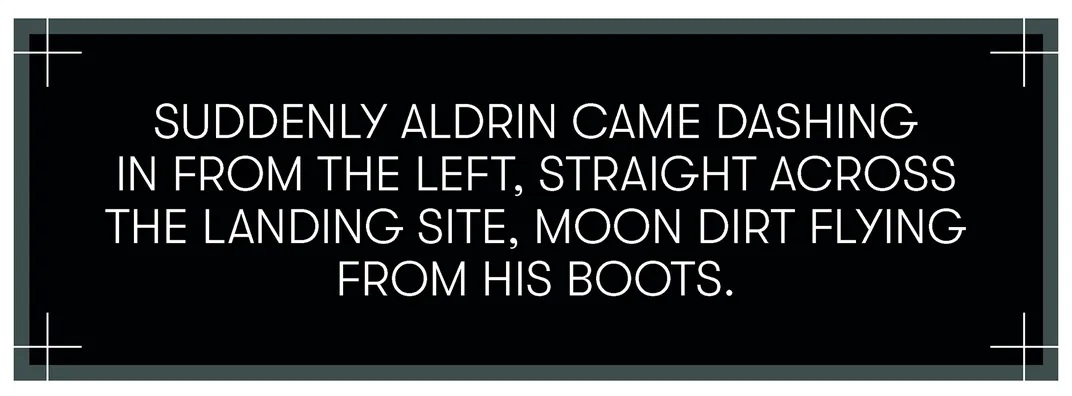
Reihm should have been having the most glorious moment of his career. By the time of the Moon landing, before he turned 30, he had become the Apollo project manager inside Playtex. His team’s blazing white suits were taking men on their first walk on another world. They were a triumph of technology and imagination, not to mention politics and persistence. The spacesuits were completely self-contained spacecraft, with room for just one. They had been tested and tweaked and custom-tailored. But what happened on Earth really didn’t matter, did it—that’s what Reihm was thinking. If Aldrin should trip and land hard on a Moon rock, well, a tear in the suit wouldn’t be a seamstress’s problem. It would be a disaster. The suit would deflate instantly, catastrophically, and the astronaut would die, on TV, in front of the world.
The TV camera, set up on a tripod, would have a perfect view. Aldrin ran left, planted his left leg, then cut to the right like an NFL running back dodging tacklers. He did kangaroo hops right past the American flag, but announced that this wasn’t a good way of moving around. “Your forward mobility is not quite as good as it is in the more conventional one foot after another,” he said. Then he disappeared from view.
By this time Reihm could barely contain his fretfulness. “That silly bastard is out there running all over the place,” he thought.
Seconds ticked by. The Moon base was quiet. Armstrong was working by the lunar module, his back to the camera. Suddenly Aldrin came dashing in from the left, straight across the landing site, Moon dirt flying from his boots. He was doing a Moon run: “As far as saying what a sustained pace might be, I think the one that I’m using now would get rather tiring after several hundred feet.”
Reihm was in a technical support room adjacent to Mission Control, with a group of spacesuit staff, standing by in case anything went wrong. Even though the whole point of the spacesuits was to explore the Moon, Reihm couldn’t wait for it to end.
Reihm’s worries weren’t unique to him. Eleanor Foraker had supervised the women who sewed the spacesuits, each painstakingly stitched by hand. When the jumping around started, she started thinking about the pressure garment, one of the inner layers of the spacesuit that sealed the astronaut against the vacuum of space. What if all that hopping and tugging caused a leak?
Joe Kosmo was one of the spacesuit designers on the NASA side. He was at home, watching with his family, thinking exactly the same thing Reihm was: “This is great. I hope he doesn’t fall over.”
Reihm knew, of course, that the astronauts were just out there “euphorically enjoying what they were doing.” If the world was excited about the Moon landing, imagine being the two guys who got to do it. In fact, according to the flight plan, right after the landing, Armstrong and Aldrin were scheduled for a five-hour nap. They told Mission Control they wanted to ditch the nap, suit up and go outside. They hadn’t flown all the way to the Moon in order to sleep.
And there really wasn’t anything to worry about. The spacesuits were marvels: 21 layers of nested fabric, strong enough to stop a micrometeorite, but still flexible enough for Aldrin’s kangaroo hops and quick cuts.
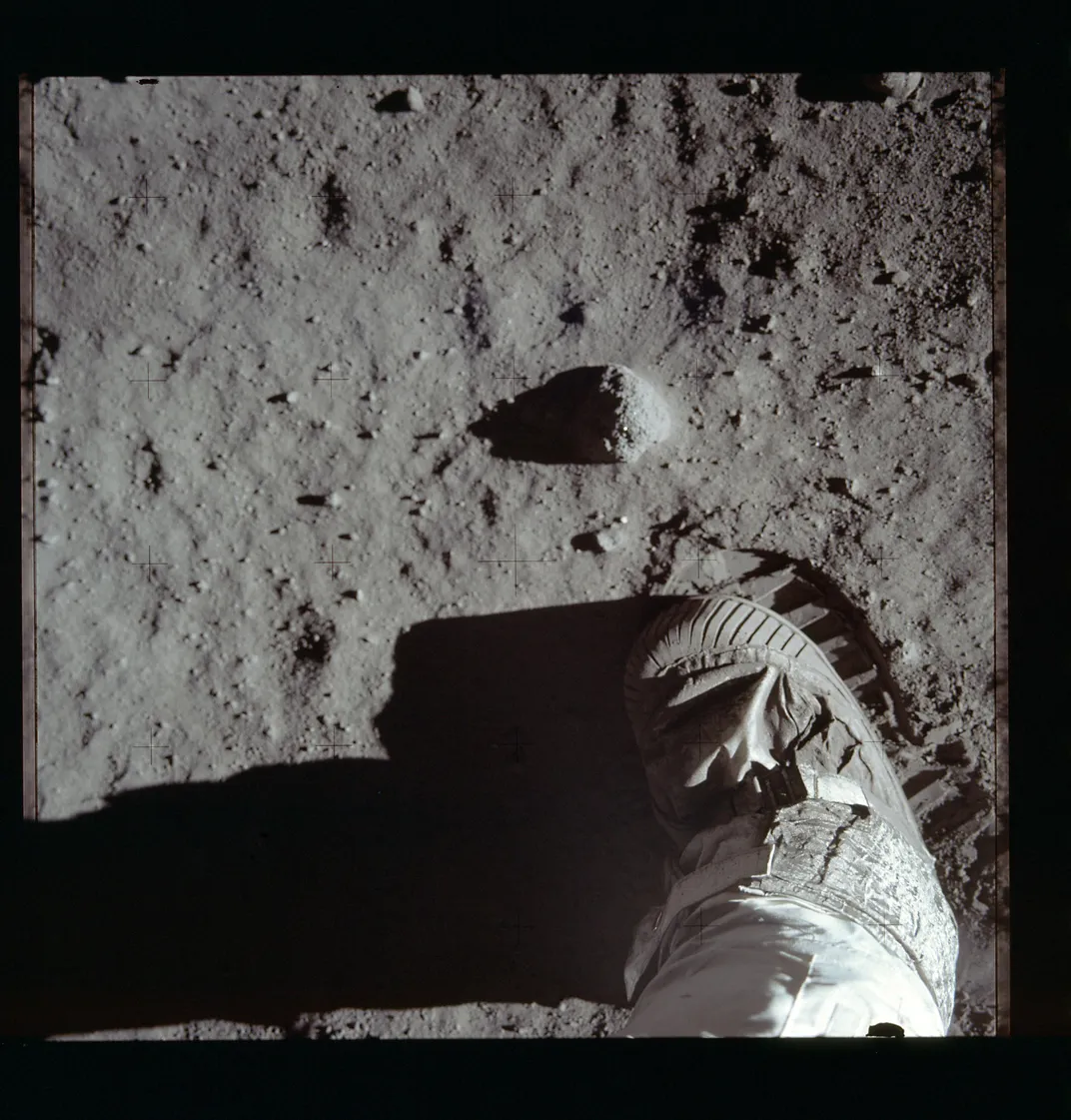
Still, watching Aldrin dash around, Reihm could “think of nothing but, Please go back up that ladder and get back into the safety of that lunar module. When [they] went back up that ladder and shut that door, it was the happiest moment of my life. It wasn’t until quite a while later that I reveled over the accomplishment.”
* * *
The Apollo 11 spaceship that carried Michael Collins, Buzz Aldrin and Neil Armstrong from the Earth to the Moon was big: The command and service module and the lunar module, docked nose-to-nose, was 53 feet long. When Collins fired the service module engine to settle into orbit around the Moon—the big engine ran for 357.5 seconds to slow the ship, six long minutes—there was already another spaceship in orbit around the Moon waiting for them. It had arrived two days earlier, from the Soviet Union.
Luna 15 was a Russian unmanned robotic craft that was at the Moon on a mysterious mission. It was certainly no coincidence that at the moment the United States was getting ready to land people on the Moon’s surface, with the whole world watching, the Russians had decided to have a spacecraft at the Moon. Luna 15 had been launched on Sunday, July 13, before the Wednesday launch of Apollo 11, and the Russians said it was simply going to “conduct further scientific exploration of the Moon and space near the Moon.”
But from the moment of Luna 15’s launch, U.S. space scientists and NASA officials speculated that it was a “scooping” mission, designed to land on the Moon, extend a robotic arm, scoop up some soil and rocks, and deposit them in a compartment on the spacecraft, which would then zoom back to Earth and maybe, just maybe, arrive back on Russian soil with its cargo before the Apollo 11 astronauts could make it home.
Frank Borman, the commander of the Apollo 8 mission that had orbited the Moon, had just returned from a nine-day goodwill tour of Russia—the first visit by a U.S. astronaut to the Soviet Union—and appeared on the NBC news show “Meet the Press” the morning of Luna 15’s launch. “I would guess it’s probably an effort” to bring back a soil sample, Borman said. “I heard references to that effect [in Russia].”
NASA, at least publicly, was mostly concerned that Russian communications with Luna 15 might interfere with Apollo 11. In an unprecedented move, Chris Kraft, the head of Mission Control, asked Borman to call Soviet contacts from his just-finished trip and see if they would supply data on Luna 15. The Soviets promptly sent a telegram—one copy to the White House, one copy to Borman’s home near the Manned Spacecraft Center—with details of Luna 15’s orbit and assurances that if the spacecraft changed orbits, fresh telegrams would follow. It was the first time in the 12 years of space travel that the world’s two space programs had communicated directly with each other about spaceflights in progress. At a press conference, Kraft said Luna 15 and the Apollo spacecraft would not come anywhere near each other.
Luna 15, at least to start, succeeded in making sure the Soviet Union’s space program wasn’t overlooked while Apollo 11 dominated the news worldwide. The Soviet mission made the front pages of newspapers around the world. At the time, NASA and the public never did find out what Luna 15 was up to. Now we know it was a well-planned effort to upstage Apollo 11, or at least be onstage alongside the U.S. Moon landing, according to documents released and research done since the breakup of the Soviet Union and thanks to the rich and detailed history of the Soviet space program written by historian Asif Siddiqi, Challenge to Apollo.
When Luna 15 arrived in lunar orbit on July 17, two days ahead of Apollo 11, Siddiqi says, Russian space officials were surprised “by the ruggedness of the lunar terrain” where it was headed, and that the craft’s altimeter “showed wildly varying readings for the projected landing area.” As Armstrong and Aldrin stepped out onto the lunar surface, Luna 15 was still swooping around the Moon, and engineers back in the Soviet Union were still trying to find a landing site they had confidence in.
Two hours before the Eagle, with Armstrong and Aldrin aboard, blasted off the Moon, Luna 15 fired its retrorockets and aimed for touchdown. The legendary British radio telescope at Jodrell Bank Observatory, presided over by Sir Bernard Lovell, was listening in real time to the transmissions of both Apollo 11 and Luna 15. And Jodrell Bank was the first to report the fate of Luna 15. Its radio signals ended abruptly. “If we don’t get any more signals,” said Lovell, “we will assume it crash-landed.” Luna 15 was aiming for a site in the Sea of Crises, about 540 miles northeast of Eagle’s spot in the Sea of Tranquillity.
The Soviet news agency Tass reported that Luna 15 had fired its retrorockets and “left orbit and reached the Moon’s surface in the preset area.” Its “program of research...was completed.”
Despite taking almost a whole extra day to figure out the terrain issues, Soviet space scientists apparently missed a mountain in the Sea of Crises. On its way to the “preset area,” Luna 15, traveling 300 miles per hour, slammed into the side of that mountain.
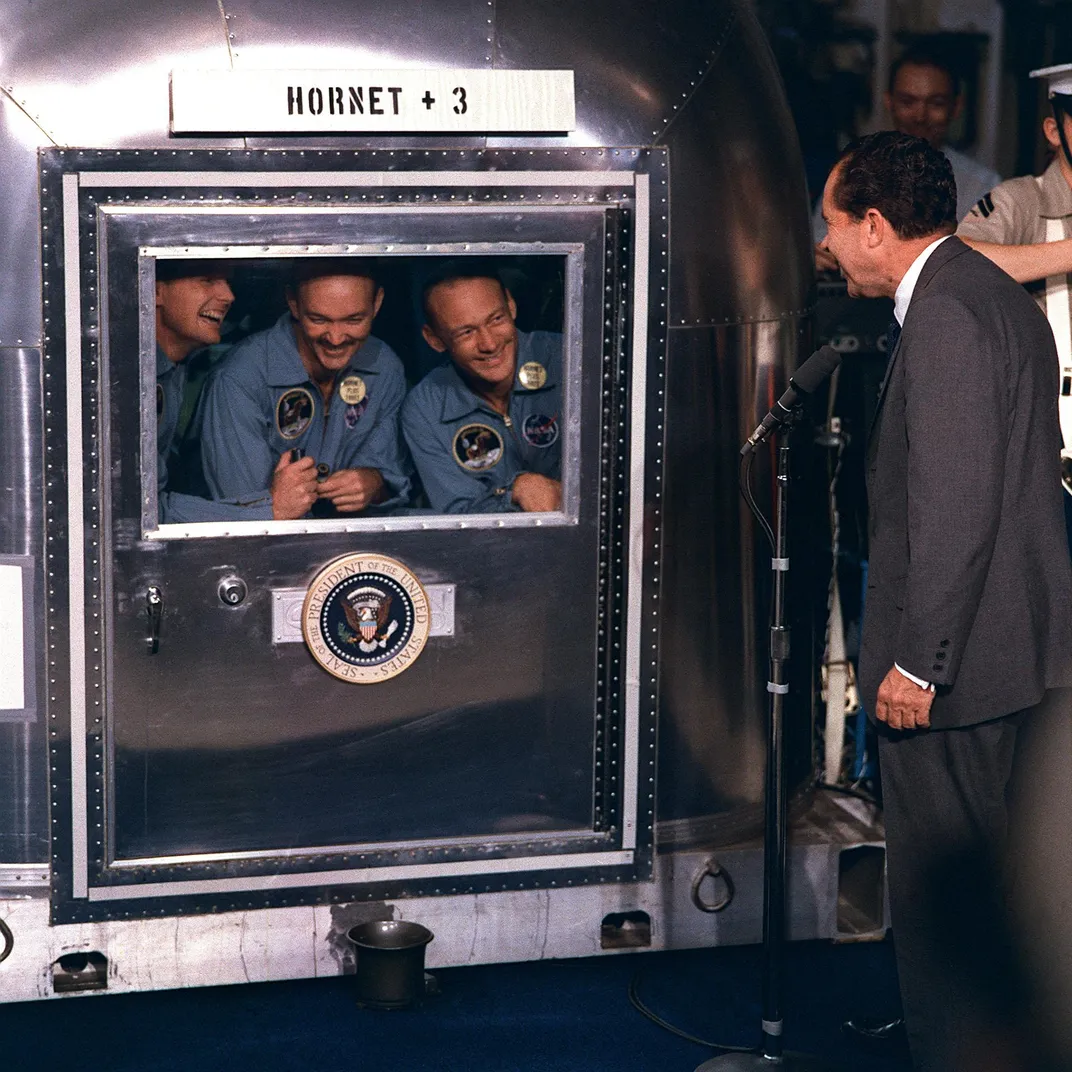
At about 1:15 p.m. Eastern time Tuesday, the Apollo astronauts woke from a 10-hour rest period and were 12 hours into their 60-hour ride back from the Moon. As they got started on their day, astronaut Bruce McCandless, Mission Control’s official Capsule Communicator, radioed, “Apollo 11, this is Houston. If you’re not busy now, I can read you up the morning news.”
Replied Aldrin, “Okay, We’re all listening.”
A lot of the news was about Apollo 11. Reported McCandless, “Things have been relatively quiet recently in Vietnam. G.I.s on patrol were observed carrying transistor radios tuned to your flight.”
About one-third of the way through McCandless’ space newscast, slipped in between telling the astronauts that President Nixon would head to Romania after meeting them onboard their recovery aircraft carrier, and the Vietnam news, McCandless reported, “Luna 15 is believed to have crashed into the Sea of Crises yesterday after orbiting the Moon 52 times.”
If ever there was a moment that captured the crushing reversal in the performance of the world’s two space programs, that was it: Mission Control matter-of-factly reporting the crash-landing of the Soviet Union’s somewhat flailing robotic attempt to collect Moon rocks to the three American astronauts flying home from the first human landing on the Moon, with 47.5 pounds of Moon rocks.
Copyright © 2019 by Charles Fishman. From the forthcoming book ONE GIANT LEAP: The Impossible Mission That Flew Us to the Moon by Charles Fishman to be published by Simon & Schuster, Inc. Printed by permission.
*Editor's Note, June 19, 2019: An earlier version of this piece noted that Neil Armstrong said "The Eagle has wings" after blasting off from the Moon. In fact, he actually uttered that phrase just after the lunar module descended to the Moon. The story has been edited to correct that fact.
A Note to our Readers
Smithsonian magazine participates in affiliate link advertising programs. If you purchase an item through these links, we receive a commission.
:focal(1000x263:1001x264)/https://tf-cmsv2-smithsonianmag-media.s3.amazonaws.com/filer/90/f0/90f0ab1d-d802-4e18-9ab8-deb642692615/jun2019_b05_apollo11.jpg)
